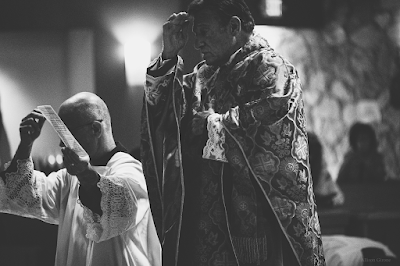By James Baresel
In the sixth chapter of Barchester Towers, Anthony Trollope describes the longstanding liturgical practices of the (overwhelmingly High Church) Anglican Diocese of Barchester. In that diocese, Theophilus Grantly, a leading priest of the diocese as archdeacon (an important administrative office) and son of the recently deceased bishop, takes certain measures in response to the Evangelicalism shared by the chaplain and the domineering wife of recently-appointed Bishop Thomas Proudie.
For Anglicans, “High Church” refers to insistence upon the type of ritual formality found in everything from a traditional Catholic Low Mass to a Solemn Pontifical one. By contrast, Evangelical Anglicans favor more casual practice. Barchester’s tradition was comparable to a Catholic diocese in which all cathedral Masses were Solemn and all parish Masses Low. But since “Proudie would abolish all forms and ceremonies…Grantly felt the sudden necessity of multiplying them” and determined that while “he could not himself intone the service…he could procure the cooperation…of curates well trained in the mystery of doing so.”
Grantly’s attitude is reflected among some Catholics devoted to the Tridentine Mass. In the Anglophone world at least, relatively few attended High Mass with regularity before Vatican II. John Henry Newman wrote that Protestants were “surprised to see the High Mass perhaps poorly attended…But, if they understood our ways, they would know that…It is early in the morning that religious persons go to [Low] Mass and Communion.” Monsignor Ronald Knox said Low Mass whenever possible and sung High Mass only when necessary. In the mid-twentieth century, parishes in American suburbs could have eight or more Masses each Sunday, of which only one would be sung. Father Uwe Michael Lang has noted that the Low Mass “was better suited to the demands of pastoral care, especially in the countryside, since it could be celebrated in places that lacked the human resources needed for the solemn liturgy. Furthermore, the simpler form of the Mass proved to be extremely useful in the worldwide missionary expansion of the Catholic Church in the early modern period.”
Early defenders of the Tridentine Mass against the post-Vatican II liturgical reformers often had similar attitudes. Critiquing proposals for liturgical reform at the 1967 Synod of Bishops in Rome, John Cardinal Heenan stressed that “Our people love the Mass, but it is Low Mass…to which they are chiefly attached” and “I cannot think that anyone with pastoral experience would have regarded the sung Mass as being of first importance.” Michael Davies approvingly quoted him after criticizing “enthusiasts who appear to believe that the reason for assisting at Mass is to sing, sing, and sing again.” Evelyn Waugh wrote that the Low Mass was the form of prayer which “most drew me [to Catholicism]” and was what “I have grown to know and love.” William F. Buckley—who for a number of years quietly arranged quasi-underground Tridentine Masses with a priest friend in Connecticut—shared that preference.
By the time I started attending the Tridentine Mass just over twenty years ago, a majority of Anglophone traditionalists may have preferred High Mass, but a preference for Low Mass was widely recognized and accepted as perfectly legitimate. Equating devotion to the Tridentine Mass with High Church inclinations could even been seen as a non-traditionalist misunderstanding or caricature. In parishes and chapels with one High and one Low Mass each Sunday, seeing comparable attendance at both or greater attendance at the latter has not been unusual even in more recent years.
Yet for some time overreaction to casual liturgical practices has in part created and in part been influenced by an attitude which insists on High Mass whenever practical—at least for Sundays and major feasts—as a matter of principle, without regard for how particular congregations pray best, and equates “traditionalism” with the High Mass.
But we must distinguish between what is best in the abstract versus what is best for particular individuals. Some people pray most fruitfully in the silence of a Low Mass as opposed to Masses that feature singing. The musically inclined often assume that all people, deep down, must share their inclination and often argue that with enough sincere practice everyone will improve how well they pray with music. But while practice can improve how well non-musical individuals pray with music, it can never bring them to the point that they pray as well with it as they do without it. Some people, too, have sensitivities to overstimulation and prefer Masses that are quieter and shorter. To pray best by singing is not universal to humanity. It is a matter of temperament or psychology.
For at least a handful of people, trying to pray through music even on rare occasions may not be worth the effort. Having once thought it would make a pleasant evening to attend a Mozart concert with friends—while in Salzburg, trapped by lack of personal transportation and a language barrier—I can assure readers that an atheist government wishing to force my apostacy would create greater temptation by dragging me to Mozart concerts daily than by threatening me with a pack of hungry lions able to end my misery within minutes.
But while I will attend High Mass no matter how elaborate the music is rather than give up the Tridentine Mass, I have known a number of people who started attending the Tridentine Mass for a time and gave it up because of how predominant High Mass was in their area. If we want attendance at the Tridentine Mass to grow, we need to do what we can to provide the variety which will attract the most people. If we want to aid people’s spiritual lives, we must take into account that different people pray better in different ways. Widespread availability of Low Mass is a necessary and beneficial pastoral measure that has withstood the test of time.
